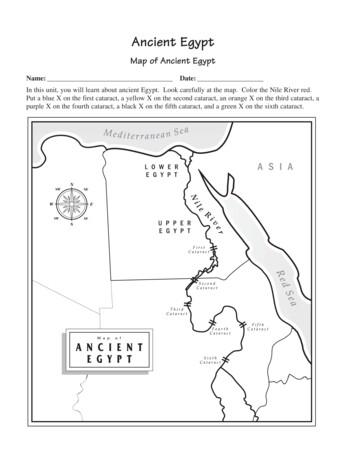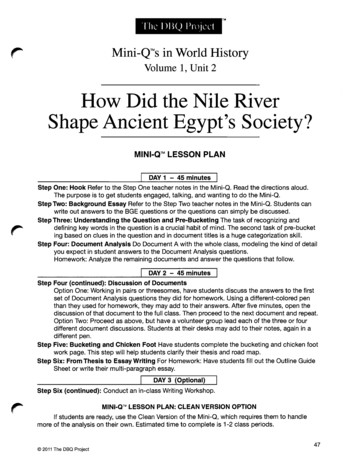Hall Of Ancient Egypt
Hall of Ancient EgyptThird FloorVocabulary (8 t h Grade):Agricultural, ancient, ancestry, branches of government, capitol, civilization, coffin, dilapidated, drought,erode, flood plain, heritage, hieroglyphic, mummification, mummy, ruins, sarcophagus, script, society,temples, pyramids, PharaohEgypt: Gift of the Nile
Which continent is Egypt located?What river runs through Egypt?After reading the text panel above, examine the map to answer the questions below.Notice the river running through Egypt and explain why the Nile River is the backbone of Egypt.What geographical formation could protect the Egyptians from foreign enemies?Extend your Knowledge! Keeping in mind what you know about the Nile River, why do you think UpperEgypt is south of Lower Egypt?
Timeline of Egyptian History
Look at the timeline above to answer the following questions.What famous Queen ruled Egypt during the Ptolemaic Egyptian time period (332 – 30 BC)?What culture surfaced in North America during Ptolemaic Egypt?Name two things that occurred in other parts of the world during the New Kingdom.1.2.According to the timeline, in what year was the Rosetta Stone created?Which time period came 1st, 2nd, and 3rd? New Kingdom, Old Kingdom, and Middle Kingdom.1st:2nd:3rd:
Map: EgyptColor and label the map with the 12 places listed below and include a compass rose. Use the text panelsthroughout this Knowledge Hunt to help you locate the areas listed.Lower EgyptUpper EgyptMediterranean SeaRome ItalyAlexandriaGreeceNile River Red SeaThebesJerusalemMemphis
Egypt’s Ancient RootsWhat natural occurrence encouraged ancient Egyptians to leave the desert and move to the Nile floodplain?When did cows become domesticated?
Extend your knowledge! Which two breeds of cattle make up the Texas Longhorn?According to the text panel on the pervious page, when did pottery appear in the ancient Egyptiantimeline?Choose one of the pottery pieces in the picture above and explain what you think it was used for. Drawit below.
The Predynastic Period (6000 – 3100 BC)What artifacts suggest that Upper Egypt and Lower Egypt were culturally distinct?How did historians gain information about this time period? What kind of items did they study?
Scripts and Writing in Egypt
What kinds of text were written in hieratic?What were scribal schools?Who was allowed to attend scribal schools?How long was the Egyptian “alphabet” made of unilateral signs? How long is our alphabet?Define hieratic.Why did ancient Egyptians start using the hieratic script in tandem with hieroglyphs?
Did you know? Naming EgyptWhy do you think the ancient Egyptians named their country Kemet to honor the Nile River?How did ancient Egyptians refer to their country?Why do you think our founding fathers named our country The United States of America?
The Pillar RoomLook at the picture of the large pillars in this room. What do you notice about their color and design? The Houston Museum of Natural Science designed the pillars inin this hall to represent the passage of time in one of Egypt’s Temples. As time passes, the pillars that once were beautiful and vibrant - like they are shown at thebeginning of the room – have now eroded or worn down – like they are shown towards the back of the room.Other than the passage of time, why do you think the colors and design deteriorated?Extend your knowledge! Choose a monument in Washington, D.C. and draw what you think it could look like in 1,000 years if they were in the dry dessert conditionslike in Egypt.
Dressing for EternityRead the description on the text panel about how ancient Egyptians like to be shown at their best appearance. Have you ever dressed to impress? Name a time thatthey have dressed up for special occasions.
Pharaoh: Lord of the Two Lands
What was maat?To whom would the king offer the “spoils of war”? How do we know?What three things was the king responsible for?1.2.3.Extend your knowledge! Which branch of government in the United States makes the laws?Who was the most powerful person in ancient Egypt?What did the word “Pharaoh” originally refer to?Extend your knowledge! As ruler of the land it would be up to the King to set rules for their people.Research a modern day King or Queen. Discover what they were responsible for in their country.
Temples
Who had access to the temples?What would happen to older temples?Why were temples made of stone?What major building in our capital is made of stone?Why do you think Egypt is “littered” with the ruins of ancient temples?
Mummification
List two types of protection that was important in the mummification process.1.2.What class of person would end up buried in the desert without any preparation?
The Old Kingdom (Dynasties 3 – 6, 2682 – 2181 BC)
When was the Step Pyramid built?Where was the Great Pyramid built?Who was the Great Pyramid built to honor?Use the space below to draw simple scaled models of the Step Pyramid and the Great Pyramid - usetriangles to represent your pyramids. Scale your model using the measurement of 100 feet equals 1 inch.
The Late Period (Dynasties 26 – 31, 664 – 332 BC)What technical disadvantage did the Egyptians suffer from during this time period? Who was better at it?Extend you Knowledge! Learn more about the goddess Neith and why she was important to Psamtek I.
Third Intermediate Period (Dynasties 21 – 25, 1069 – 664 BC)
Why do you think historians believe the Nubian Pharaohs were more Egyptian than Egyptians?Write an argument agreeing or disagreeing with historians and give two reasons. Sight one source todefend your answer.List two innovations the Intermediate Period was known for.1.2.Coffins became the main focus during the Intermediate period. What was painted of the coffins?
Giant Coffin with Green Face vs. Coffin of TjefutLook at both coffins pictured above. Give two examples of how they are the same and how they are different.
Did you know? SarcophagusAre all coffins sarcophagi? Why or why not?
Roman and Byzantine Egypt (30 BC – 641 AD)When did Egypt become a province of the Roman Empire?What religious belief became popular during the 3rd century AD? How did this affect the burial process?
Egypt in England: Chiddingstone Castle and the Collections ofDenys Eyre BowerWhat major event caused Denys Bower to become fascinated with Egypt?
The Dollar BillLook at the U.S. dollar bill, what do you see that reminds you of Egypt?What does the unfinished pyramid, on the US dollar bill, possibly mean?
The Rosetta Stone
How did historians learn to “decode” hieroglyphics using the Rosetta Stone?What three languages are written on the Rosetta Stone?1.2.3.Which of these three languages did historians use to unlock the mystery of Egyptian writing?
Map: Egypt Color and label the map with the 12 places listed below and include a compass rose. Use the text panels throughout this Knowledge Hunt to help you locate the areas listed. Lower Egypt Upper Egypt Nile River Red Sea Mediterranean Sea Alexandria Thebes Memphis Rome Italy Greece Jerusalem
Ahmed Abdel Ahad Donia Egypt Samer Moustafa Mohamed El Sayed Egypt Ahmed Mohammed Ibrahim Obaid Egypt Yasser Elsaadawy Egypt Ahmed Salah Behiry Dr. Egypt Zakaria Ahmed Rashad Mohamed Eqypt Amira Salah Hassan Said Egypt Aleykutty Shaji India Ayman Ibrahim Alnwehi Egypt Annamma Anandamadam Othman India
This is the third paper in a series of research papers exploring the history of mechanical engineering during the Ancient Egypt era. The industry of necklaces in Ancient Egypt is investigated over seven periods of Ancient Egypt History from Predynastic to Late Period. The paper presents samples of necklaces from the seven periods and tries to .
Egypt was a grassland. Nomads traveled in search of food King Menes united Upper & Lower Egypt. Established capital at Memphis. Age of Pyramids. First man made mummies Romans take control of Egypt. Egypt never rises to greatness again. Alexander the Great conquers Egypt. Cleopatra is the last Phar
The first pharaoh of Egypt was Narmer, who united Lower Egypt and Upper Egypt. Egypt was once divided into two kingdoms. The kingdom in Lower Egypt was called the red crown and the one in Upper Egypt was known as the white crown. Around 3100 B.C. Narmer, the pharaoh of the north, conquered the south a
Around 3100 BC, there were two separate kingdoms in Egypt, Upper Egypt and Lower Egypt. Soon aerwards, King Narmer (from Upper Egypt) united the t wo kingdoms. When the unificaon happened, it became the world ’s first ever na†on -state. King Narmer was the first king of Egypt ’s
Ancient Egypt Vocabulary (cont.) 13. Nubia—ancient civilization located to the south of Egypt 14. Old Kingdom—period in ancient Egyptian history from 2686 B.C. to 2181 B.C. 15. papyrus—a plant that was used to make paper 16. pharaoh—ancient Egyptian ruler who was believed to be part god and part human 17. phonogram—a picture that stands for the sound of a letter
more true than in the ancient kingdom of Egypt. Ancient Egypt was a world of contrasts and op- posites, a place of hot, sunny days and cold nights, of crop- laden fields and empty desert. In its early time, the kingdom was actually two distinct lands called Upper Egypt (the higher the delta. Irrigation channels from the Nile flowed to smaller
Temples of Ancient Egypt There were many temples in ancient Egypt – features: - Square building, large limestone blocks, granite roof, alabaster floors - Some attached to pyramids for burial rites and worship-Trabeated construction-Hypostyle hall Temple of Philae, Aswan, Egypt























